#kingedwardi
Photo

On This Day In Royal History
.
28 November 1290
.
Eleanor of Castile died
.
👑 Eleanor was the first queen consort of king Edward I of England.
.
◼ Shortly after the birth of her fifteenth child (she had at least sixteen known pregnancies), Beatrice, Eleanor’s health began to deteriorate. In 1287, while she was in Gascony she suffered from a double quartan fever, which was possibly a strain of malaria.
.
◼ In the autumn of 1290, The King & Queen travelled towards Lincoln, Eleanor was unwell with a feverish illness, probably a recurrence of the quartan fever of 1287. Eleanor’s condition worsened as they reached the village of Harby, in Nottinghamshire, & she died there, with Edward at her bedside on the evening of the 28th November 1290, aged 49.
.
.
.
.
#OnThisDayInHistory #thisdayinhistory #theyear1290 #d28nov #Eleanorofcastile #history #houseofIvrea #EnglishMonarchy EleanorsCross #Plantagenet #Houseofplantagenet #Thequeen #BritishMonarchy #RoyalHistory #medieval #medievalhistory #medievalqueen #medievalart #Onthisday #Kingedwardi #EdwardI #plantagenets #queenofengland #Historyfacts #England #Historicengland #otd #RoyalHistory #OnThisDay (at Harby, Nottinghamshire)
https://www.instagram.com/p/CIJn9yaj3j2/?igshid=341kbf8j2som
#onthisdayinhistory#thisdayinhistory#theyear1290#d28nov#eleanorofcastile#history#houseofivrea#englishmonarchy#plantagenet#houseofplantagenet#thequeen#britishmonarchy#royalhistory#medieval#medievalhistory#medievalqueen#medievalart#onthisday#kingedwardi#edwardi#plantagenets#queenofengland#historyfacts#england#historicengland#otd
15 notes
·
View notes
Photo

#kingedwardi #longshanks #statue #burghbysands #igerscumbria #instacumbria #solwaycoast #monochromatic #history #englishmonarchy #instafollow (at Burgh By Sands)
#instafollow#monochromatic#statue#burghbysands#longshanks#englishmonarchy#igerscumbria#instacumbria#history#solwaycoast#kingedwardi
0 notes
Text
Saint John of Beverley
One of the most interesting and inspirational religious legends I have researched is that of Saint John of Beverley.
John of Beverley was an English bishop active in the kingdom of Northumbria.
He was the bishop of Hexham and then the bishop of York, which at that time was the most important religious designation in the area.
He went on to found the town of Beverley by building the first structure there, a monastery.
John was associated with miracles during and after his lifetime, and was canonised a saint by the Catholic Church in 1037.
John was said to have been born of noble parents at Harpham, in the East Riding of Yorkshire, he is said to have received his education at Canterbury under Adrian of Canterbury and not Oxford as per some sources. However, all these facts are first recorded after his canonization in 1037, and may not be reliable.
He was for a time a member of the Whitby community, under St Hilda, a fact recorded by his friend Bede. He won renown as a preacher, displaying marked erudition in expounding Scripture.
In 687 he was consecrated bishop of Hexham and in 705 was promoted to the bishopric of York.
Of his new activity little is known beyond that he was diligent in visitation, considerate towards the poor, and attentive to the training of students whom he maintained under his personal charge. He ordained Bede as a deacon and as a priest.
He resigned perhaps about 717 and retired to a monastery which he had founded at Beverley, where he died on 7 May 721.
John was canonised in 1037 and his feast is celebrated annually in the Roman Catholic Church on 7 May. His translation is celebrated on 25 October.
Many miracles of healing are ascribed to John, including healing a boy who could not speak and his pupils were numerous and devoted to him, and the popularity of his cult was a major factor in the prosperity of Beverley during the Middle Ages. He was celebrated for his scholarship as well as for his virtues. Around 1066, Folcard was commissioned to write a Life of John.
An account of John's miracles was written by William Ketel in the 11th or 12th century which contains the first mention of King Æthelstan's visit to Beverley.
The earliest existing mention of John's banner is in 1138 when Thurstan incorporated it into the standard which gave its name to the Battle of the Standard. This is a powerful symbol of the belief in John and his resultant influence.
A further example of this influence is that by 1266 it was accepted that when levies were made in Yorkshire for the royal army, it was sufficient for Beverley to send one man with the banner of John. In 1292 a new shrine was commissioned. An extant contract between Roger de Faringdon and the canons of Beverley Minster states:
'For a silver-gilt shrine, made from gold and silver supplied by the Chapter, 5ft long, 1ft wide. Of proportionate height, beautiful, and adorned with plates and columns in architectural style with figures everywhere of size and number as the Chapter determine, and canopies and pinnacles before and behind, and other proper ornaments. Roger to remake any figure at the whim of The Chapter. The pay to be silver equal to the weight used before gilding. Roger may not undertake any other work before completion.'
Edward I was a devotee of John and furthered the cult. This is a King of England, devoted to John and what is being referred to as a cult. What was it that enabled John's influence. What knowledge powered his leadership of the cult.
In 1295 Edward established a chantry in Beverley Minster in the saint's honour. In 1301, he gave 50 marks towards the building of the shrine and diverted half of a fine owed by the town to the same purpose and ceded the remaining half.
On 25 October 1307 John's relics were translated to the new tomb.
Edward I visited the Minster in 1296, 1297, and 1300 on his way north to fight with the Scottish and took the banner of John to aid him. Edward II, Edward III, and Henry IV also used the banner in military campaigns. This is a stunning indication of how influential John and his teachings had become. Edward I visiting three times to collect a banner of John whilst en route to battle. This indicates a devoted belief that a cloth with symbolism of John on it was enough to provide power of sorts to an army. Not only this but four Kings in total continued to do that same through the ages.
During the Middle Ages his name was also attached to the legend of a hermit who commits grave sins but nonetheless enjoys God's grace. This text survives in the Dutch chapbook Historie van Jan van Beverley, printed by Thomas van der Noot in Brussels in c.1512.
Henry V gave the credit for his victory at the Battle of Agincourt to the miraculous intervention of John, the battle having been fought on the anniversary of John's translation. On the day of the battle, blood and oil were seen running from the tomb. Henry made John one of the patrons of the royal household and ordered that his feast was to be celebrated throughout England. Henry and his queen came to Beverley in 1420 to make offerings at the saint's shrine.
The relics of John of Beverley are housed there, covered by a marble slab.
In 1541, the shrine was destroyed on the orders of Henry VIII as part of the English Reformation. Its contents disappeared from records. In 1664, workmen discovered a vault under the floor of the minster's nave. Made of stone, it was 15 ft long (4.6 m) and 2 ft wide (0.61 m) at the head and 1 ft wide (0.30 m) at the base. Encased in lead, were found ashes, six beads, three great brass pins and four large iron nails. The lead had the following inscription:
'In the year from the incarnation of our Lord, 1188, this church was burnt in the month of September, the night after the feast of St Matthew the Apostle and in the year 1197, the 6th of the ides of March, there was an inquisition made of the relics of the Blessed John in this place, and these bones were found in the east part of this sepulchre, and redeposited; dust mixed with mortar was found likewise and re-interred.'
Why were the remains and relics encased in lead? This was either to protect the contents from the outside world or to preserve them for longer, perhaps to preserve their symbolic power or to protect the outside world from it.
The inscription indicates that the Roman Catholic church was so interested in the relics and what they represented that an inquisition was dispatched to locate and examine them. Were the brass pins and iron nails relics of the cross on which Christ was crucified. Were these relics in John's position through association with the Templars, removed from Jerusalem, hidden and protected by a knight who by their possession became the most venerated religious leader of his time, who made devotees of Kings and could win battles for them with only the symbolism of his banner.
Relics of this type have always commanded the belief that they harbour a power bestowed on them by their religious relevance and contact with the idols of religious belief.
In 1738, when the present minster floor was laid, the same relics were dug up and replaced in the same position with an arched brick vault over them. Although this is stated it is non-descript in that the relics at this point may be a reference to the lead lined vessel or were the relics replicas left by the inquisition because it would be logical for the relics of such potential and with such history, whether legitimate or not, to be relocated to the Vatican for closer examination, safe keeping or to remove their idol influence by incorporating it into the church.
The vault was covered by a marble slab, similar to others in the nave and headed with a distinctive Templar coss. On the roof of the church, over the tomb, Reliquas beati Johanis Beverlacenic his undicat.
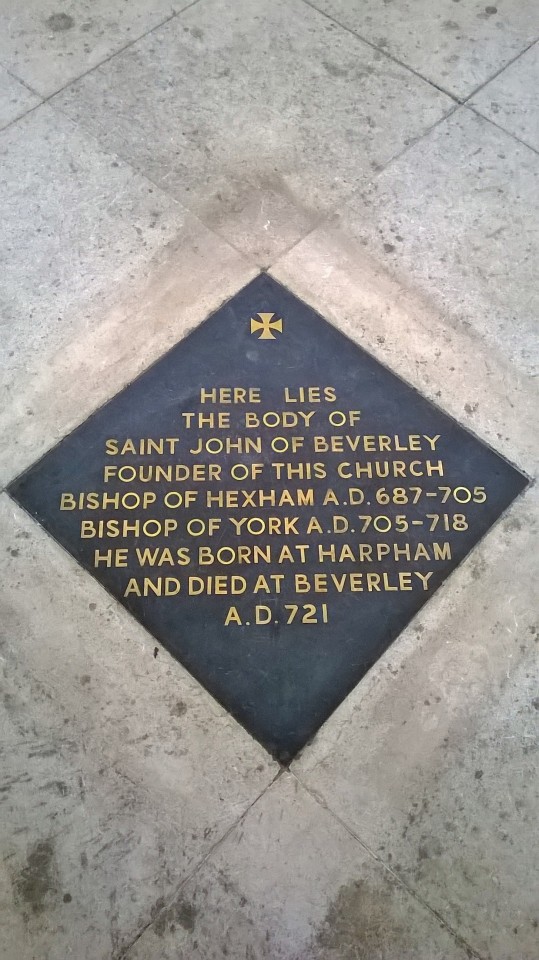
In recent times, the feast of St John has been marked in Beverley in two ways. On the Thursday nearest 7 May the choir and members of the congregation of Beverley Minster go the church at Harpham and process to the well. The well is decorated (before the event) with flowers. After singing an anthem and praying, the procession returns to the church for choral evensong.
On the Sunday nearest 7 May the civic dignitaries process in full regalia with mace bearers to the minster. The procession enters by the Great West Door. During the following service, children from Harpham present primroses gathered from the woods around the village. The flowers are placed around John's tomb.
Beverley Minster in Beverley, East Riding of Yorkshire, is a parish church in the Church of England. It is one of the largest parish churches in the UK, larger than one third of all English cathedrals and regarded as a gothic masterpiece by many.
I was inspired by the scale, grandeur and detail of what is without doubt a masterpiece in architecture, art, religion and symbolism.
It is a prelude model to York minster and incredible to contemplate that this is essentially a cathedral which is not classified as such but as a parish church. It was the first part of Beverley and it’s difficult to comprehend the comparison to what most would consider a parish church.
It surprises you as you arrive because it is just suddenly there, so great and grand from such a small town. I love how the image has also captured a bird soaring high overhead, perhaps symbolic of the power of this place.

Originally a collegiate church, it was not selected as a bishop's seat during the Dissolution of the Monasteries; nevertheless it survived as a parish church and the chapter house was the only major part of the building to be lost. It is part of the Greater Churches Group and a Grade I listed building.
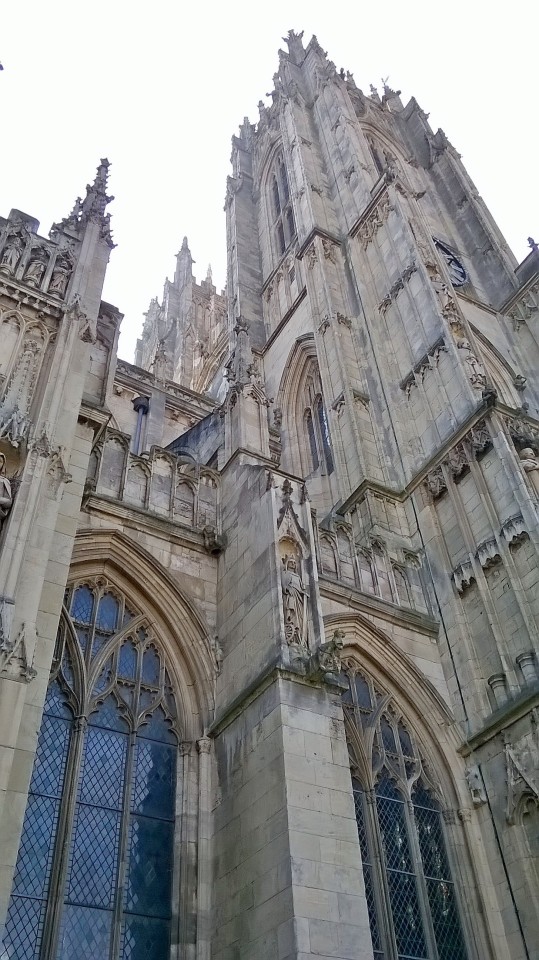
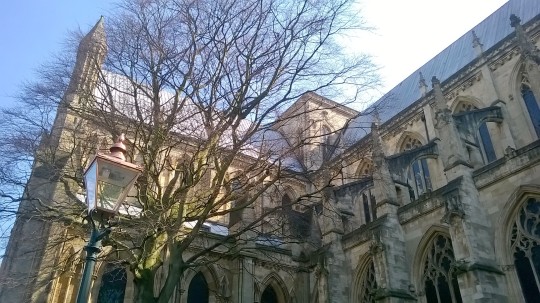
There are exquisite, aged coloured glass windows and high arches with coloured, smooth pillars of varied height creating drop points for the sweeping stone ceiling arches.

Ancient commemorative flags hang in clusters creating an air of still and age.

The chapel of the East Yorkshire Regiment is a work of art: a highly decorative screen frames the sparkling mosaic work of the cenotaph beyond with beautiful mosaic inlain twisted pillars in memory of soldiers killed in WW1.

In another chapel is the Henin Cross.
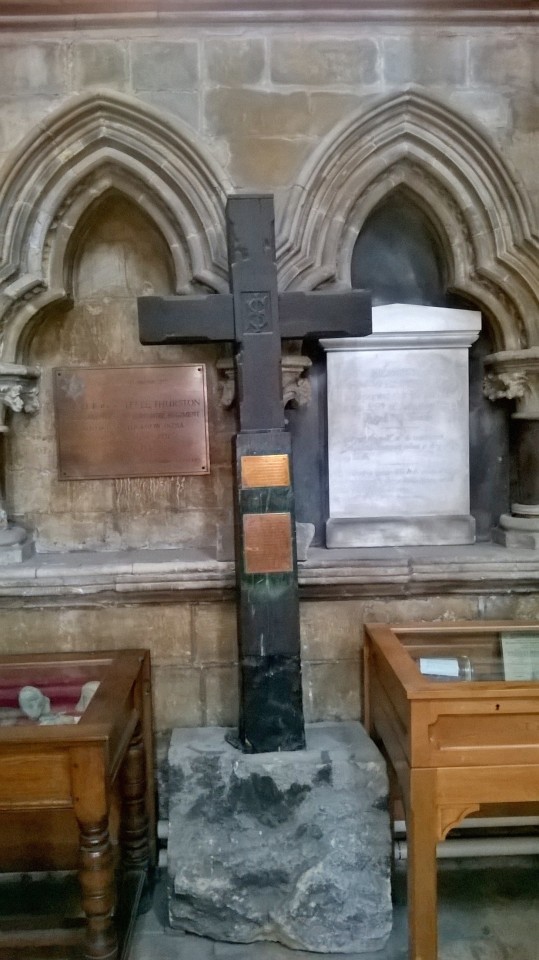
The central raised organ, built by John Snetzler, installed in 1769, is glorious in the beauty of the intricate wood carvings, female guardian figures and floral symbols. The attractive formation of the flutes and the decorative wooden arch that beckons you through to the linear figurines and coloured windows beyond.
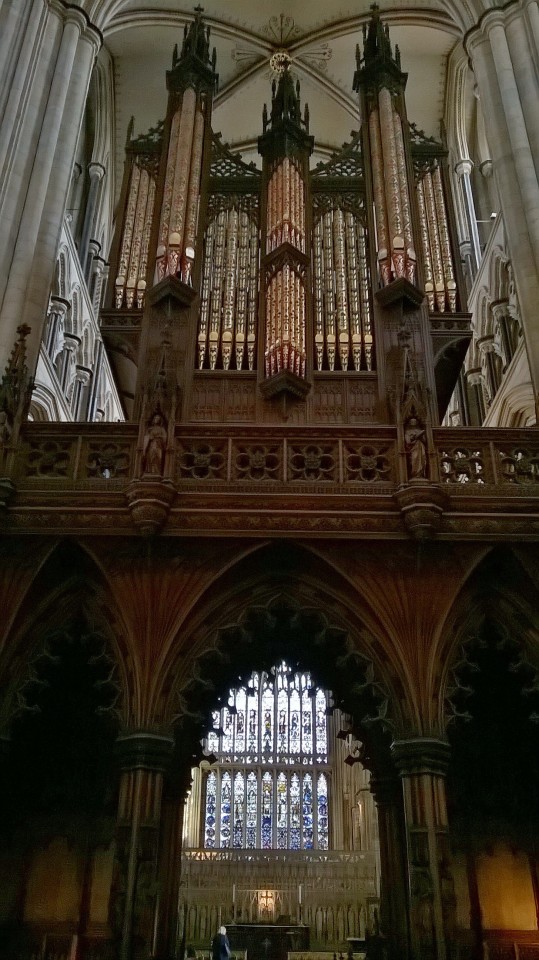

The carvings and detail of the wooden bridge supporting the organ are incredibly beautiful, flowing and spreading and connecting through the wood with intricate detail. It was designed by Gilbert Scott and carved by local woodcarver James Elwell in 1880.

Beyond the ornate wooden arched entrance is an overwhelming, ornately decorated Quire containing 68 early 16th century stalls. Each 'misericord', or mercy seat, has a unique carving underneath and features saintly figurines and gargoyles. The canopies, restored in the 18th century, contain 20th century carvings. Near the High Altar is the 8th century frith stool, possibly a bishop's chair or sanctuary chair. The Quire is used daily for prayer.

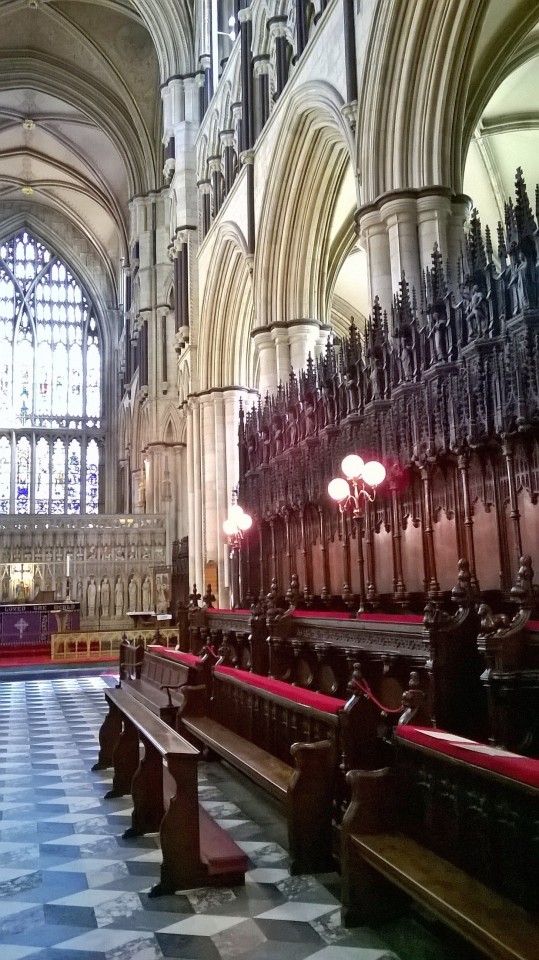
The depth of the carvings are beautifully intricate and depth of the gothic spires are wonderful. Each gargoyle and figurines are all unique and of interesting reference.

Each entry through the first row of choir seats to the second row of choir seats features perched figurines of unusual gothic combinations of beasts and creatures. Including a griffin / lion legged body with a Grecian style, headed bust.

Other fantastic example include a two legged dragon and unusually seated horse.

Elsewhere there is a more traditional looking dragon and a griffin.

As you progress through the church it continues provide wonderful glimpses of the depth of the stone work decorating the walls, pillars and ceiling. The lines, coloured slender, cylindrical pillars and pointed gothic arches provide incredible detail that draw the eye in.

The linear, order and intricately detailed stone work is epitomised at the high altar, which appears guarded by saints lined along each side and the disciples immediately behind.

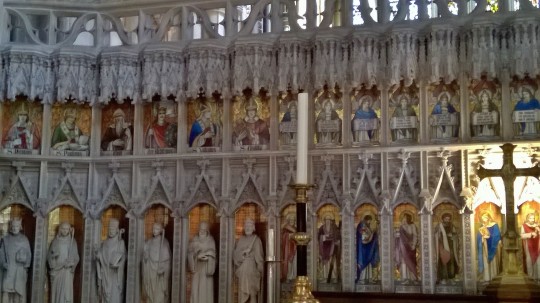
This continues in the immense beauty of the walls, ceiling and stain glass window above and behind the high altar.
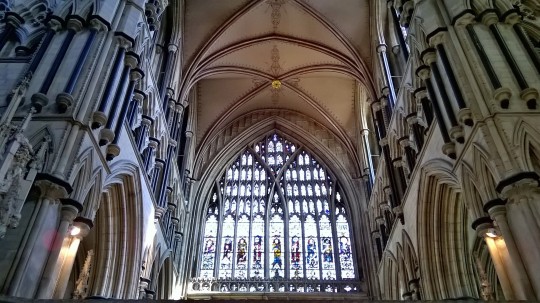
The beauty again draws your eye into greater detail as it draws your eye up further into the ceiling until you see the intricate, elegance of the painted vaulted ceiling above the high altar.

Following the sand coloured stone, black lines and rich brown wood, suddenly a burst of intensely blue and red stained glass.

This bright, new window is to the side of the incredibly elegant lines, squares and circles that smooth into delicate, gothic archways with greater and greater details in smaller and smaller windows.

The sun cascades through the brightly coloured, new window to spill over the memorial urn at the base of the East window in the retro-choir where thousands of pilgrims came to pray to Saint John of Beverley whose remains were placed in a shrine on top of the reredos. The East window contains the Minster's only high quality medieval glass.

In a private memorial to the side of the central hall hang flags so ancient that they are poignantly thread bare in testimony to the honour of remembrance that they represent.
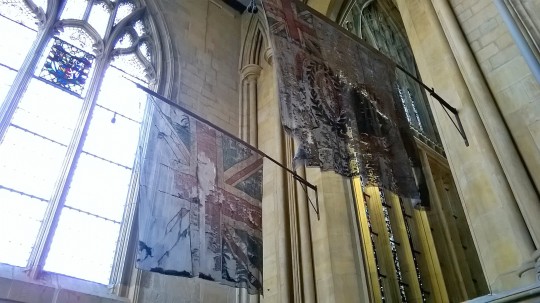
One of most favourite pieces of art in the church is this figurine of an apostle or Christ, depicted as the shepherd. I particularly love that the gold point that once may have covered the head and hands appears to have faded and worn off with time to reveal the true colour of the figurine, the true colour of the basis of the religion, the true colour of the human race.

As I left the private chapel in which the figurine stands I caught possibly the most inspirational view of the church, both gothic and renaissance in the intricate carvings of decorated stone, the clean linear black cylindrical columns, the sweeping archways, leading up to the delicately painted ceiling. This is the Percy Canopy, which dates from about 1340. It is regarded as a masterpiece of Gothic style. It is believed to commemorate Lady Eleanor Percy who died in 1328. The Percys were the most powerful nobles in the north at that time.

Each annex of the cross shaped church is filled with clean lines, multi-cylinder columns, flowing archways and here another, detailed, bright stained glass.

The lines, columns and arches lead ever upwards into the cathedral like heights of the ceiling, which itself is geometrically beautiful, creating crosses and triangles in its folds.
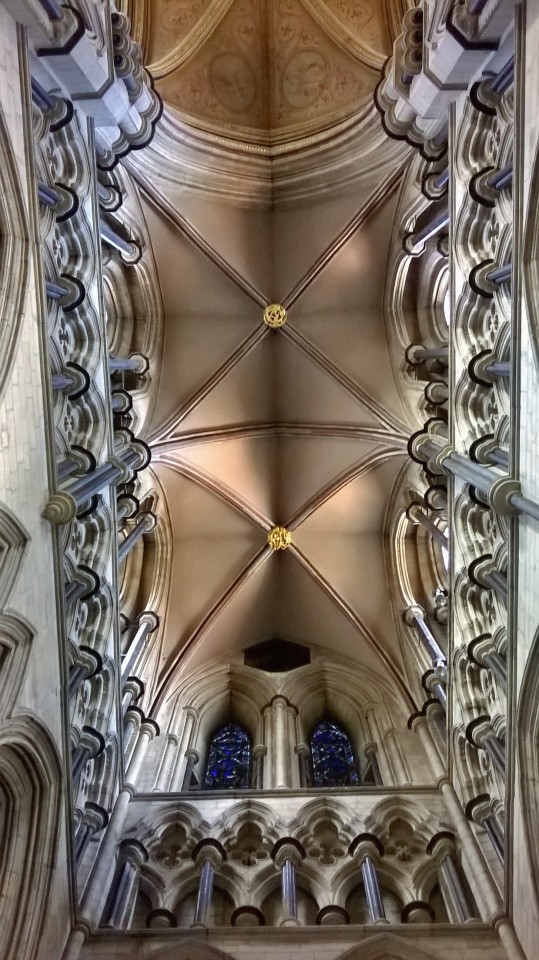
Another glimpse into the depth of the beauty of the intricate stone carvings, sweeping lines with references to the shapes of Middle Eastern architectural reference, stone figurines, the delicate detail of the carved wood, the bright coloured glass and renaissance painted ceiling.

Every view is rich with the simple lines that reach into sweeping archways.
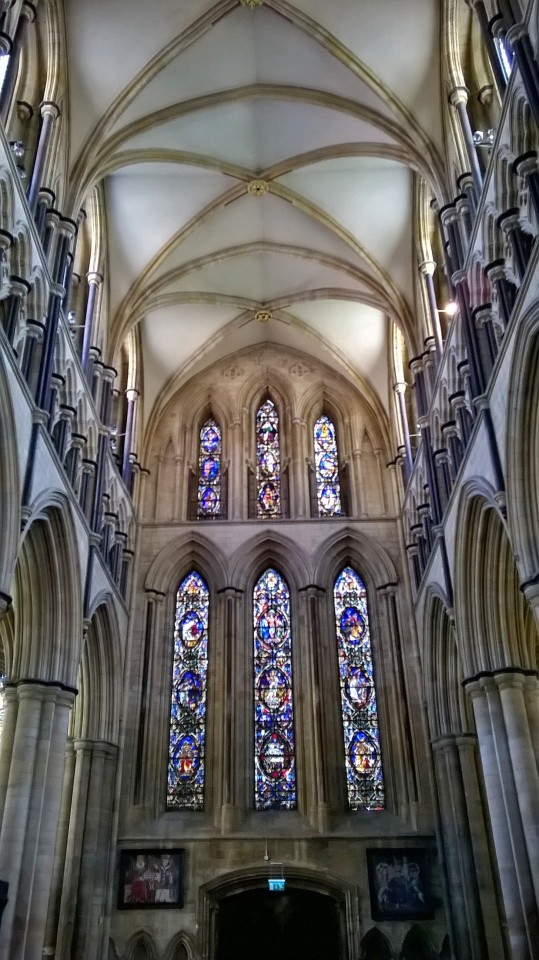
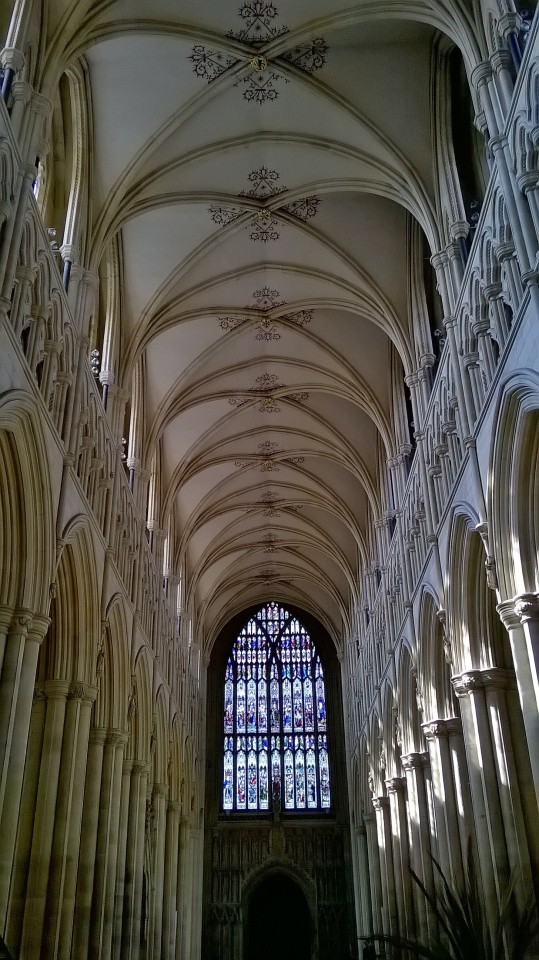
The beauty of the church is immense and continually reveals new visions of depth, architectural artistry and light.


Throughout the lines and arches are punctuated by the flowing lines, curves and shapes resembling natural, floral growth.

The stone masonry is so significant in beauty and detail that the finest stone masons must have taken part in the construction. This work have been of great pride and there is evidence of masons signing and dating their work or is this 18th century graffiti.

Some low level examples of the stone art bear resemblance to the previous, gothic wooden creatures in the choir. The stone creatures are equally unusual and depictive, like this clothed fox, standing like a humanoid and the standing goat swaddling a pair of children.

A wonderful example is the unusual figurine below holding under one arm a dragon biting their hand and a parrot like bird in the other, pecking or feeding from the other hand.
Note as well the detail in the small arch to the right of the figurine. A human in a skirt or kilt, holding a sword, perhaps wearing armour and an unusual hat or helmet.

The statue of St John of Beverley below is particularly fascinating. One close inspection his robes are decorated with a Templar cross and leaves, representative of pre-Christian, pagan beliefs. In the base, below his feet at ghostly depictions of the Green Man.
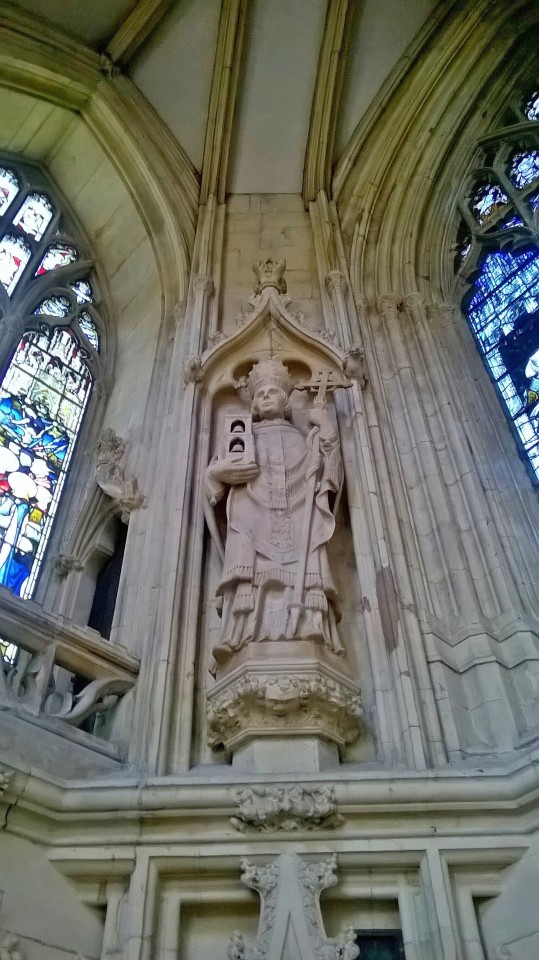
The Hawksmoor designed West door serves as the main door to the central aisle is another incredible example of the beautiful curves and shapes. Carved scholars stand above zodiac symbols, perhaps as a depiction of how knowledge is founded on Babylonian astronomy, which dates from the 1st century BC.
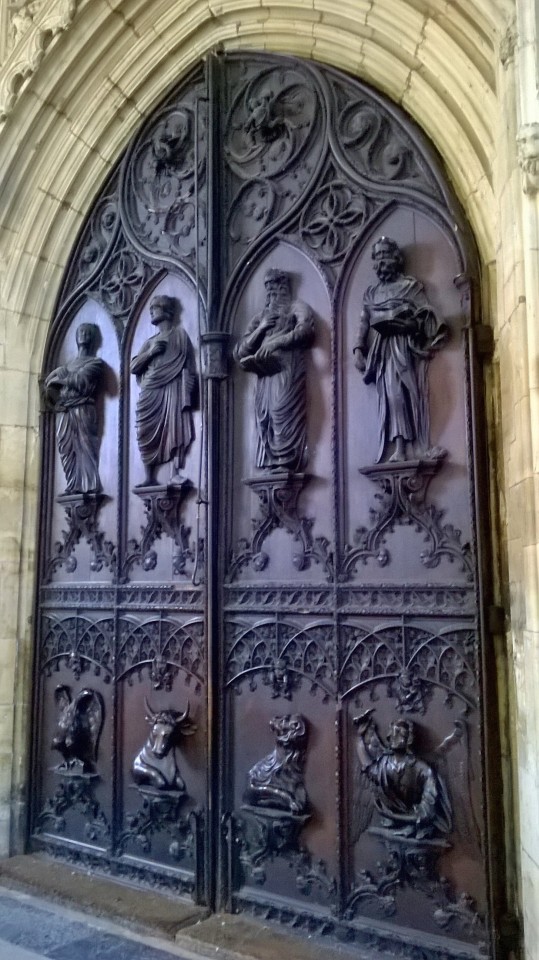
This may be a reference to the foundation of Christianity on the more ancient Chaldean religion.
Christian tradition links the four Evangelists (the attributed authors of the canonical Gospels) with four symbols: Matthew with a Man or Cherub, Mark with a Lion, Luke with a Bull and John with an Eagle.
In Christianity, these symbols are derived from Ezekiel's famous vision in which he saw four creatures, each with four faces, as described in Ezekiel 1:10:
"Their faces looked like this: Each of the four had the face of a man, and on the right side each had the face of a lion, and on the left the face of an ox; each also had the face of an eagle."
Parts of this vision are rehashed by John in Revelation. In the fourth chapter, four creatures are again encountered, and their appearance is described in Revelation 4:7:
"The first living creature was like a lion, the second was like an ox, the third had a face like a man, the fourth was like a flying eagle."
This may be an example of how the church incorporated the Chaldean beliefs into the Bible and Christianity in order to assert control of doctrine and religious beliefs.

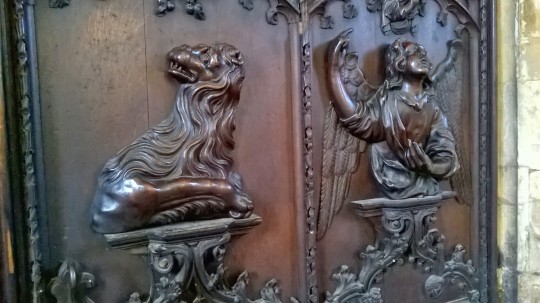
The Frosterley marble font dates from the earlier Norman Church about 1170. It is adorned with an incredibly ornate winged cherub heads which appear to be at the end of floral, vine like necks that wind down the sides of the 18th century font lid. This peaks at a urn like carving, topped by an unusual bird. It would normally be a dove, however, this has more bird of prey like features in its long neck and turned head. At the crest of the lid is a finer, twills of vine growing up to the supporting chain.
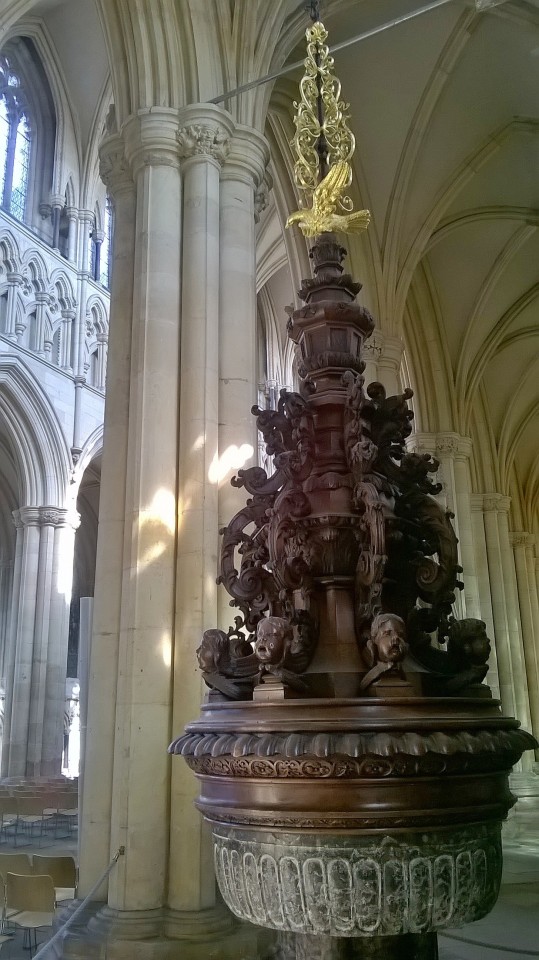
#saint#john#saintjohn#beverley#church#church of england#northumbria#yorkshire#kingedwardi#kingedwardii#king edward iii#king henry iv#king henry v#agincourt#gothic#greenman#templar#knight templar
0 notes
Video
After capture by the English and King Edward I, Wallace was hung, drawn and quartered. His head was put on a spike in London and his limbs were displayed separately in Newcastle, Berwick, Stirling and Perth. . #WilliamWallace #Braveheart #BattleOfStirlingBridge #MelGibson #Newcastle #Stirling #Perth #Berwick #Scotland #KingEdwardI #Elderslie #BareBonesFacts #HistoryFacts #illustration #joysticksnsliders #CharacterDesign #PotionPictures #Animation #LoveHistory #Instahistory #Historygram #FunFact #ScottishHistory #Freedom #ScotSpirit #MarcMorris #EdinburghCastle #BattleOfFalkirk #FreedomFighter @visitscotland (at Stirling Castle)
#scotland#berwick#freedom#scotspirit#instahistory#edinburghcastle#barebonesfacts#battleoffalkirk#lovehistory#characterdesign#williamwallace#battleofstirlingbridge#animation#stirling#historygram#marcmorris#melgibson#potionpictures#joysticksnsliders#newcastle#braveheart#scottishhistory#perth#freedomfighter#kingedwardi#elderslie#illustration#funfact#historyfacts
0 notes
Photo
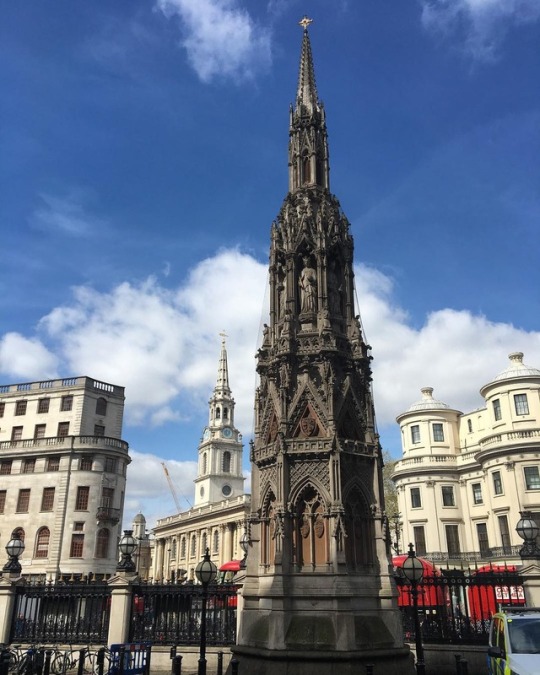
A replica of Eleanor Cross outside of London Charing Cross Station. Twelve of these lavish stone monuments topped with a cross were originally commissioned by King Edward I for his wife Eleanor of Castile but very few survived. Apparently this was to mark the 12 places where her body rested when transported from Lincoln to London for burial at Westminster Abbey. Off in the distance is the spire of St Martin-in-the-Fields Anglican Church which is at the north-east corner of busy Trafalgar Square! . . . #EleanorCross #KingEdwardI #EleanorOfCastile #LondonCharingCross #Spire #StMartinInTheFields #Churches #AnglicanChurch #ThisIsLondon #LondonIsOpen #VisitLondon #LondonLiving #ILoveLondon #LoveLondon #Londonist #London_Only #LondonLive #TheLondonLifeInc #SecretLondon #MySecretLondon #LondonForYou #UnlimitedLondon #LondonCityLife #LondonCity #LoveLondon #London4All #MyDarlingLondon #ThisIsLondon #Londongram #IgersLondon http://ift.tt/2ncLSYQ
0 notes
Photo

On This Day In Royal History
.
16 November 1272
.
Edward I accession
.
◼ On 16 November 1272, the day that his father King Henry III died, Edward was fighting in the crusades.
.
◼ It was not until 24 September the following year that Edward left Acre. Arriving in Sicily, he was met with the news that his father had died. Edward was deeply saddened by this news, but rather than hurrying home at once, he made a leisurely journey northwards. This was partly due to his health being poor, but also due to a lack of urgency.
.
◼ The political situation in England was stable after the mid-century upheavals, & Edward was proclaimed king at his father’s death, rather than at his own coronation, as had until then been customary.
.
◼ In Edward’s absence, the country was governed by a royal council, led by Robert Burnell.
.
◼ The new king embarked on an overland journey through Italy & France, where among other things he visited the pope in Rome & suppressed a rebellion in Gascony. Only on 2 August 1274 did he return to England, & was crowned on 19 August.
.
.
.
#OnThisDayInHistory #ThisDayInHistory #TheYear1272 #Accession #EdwardI #EdwardIofEngland #historyfacts #KingEdwardI #KingofEngland #History #HouseofPlantagenet #Plantagenet #Plantagenets #EdwardLongshanks #EnglishMonarchy #otd #OnThisDay #Medieval #MedievalHistory #medievalart #medievaltimes #royalfamily #theking #BritishMonarchy #D16Nov
https://www.instagram.com/p/CHqrNZADUaD/?igshid=1e44l86b8k3fc
#onthisdayinhistory#thisdayinhistory#theyear1272#accession#edwardi#edwardiofengland#historyfacts#kingedwardi#kingofengland#history#houseofplantagenet#plantagenet#plantagenets#edwardlongshanks#englishmonarchy#otd#onthisday#medieval#medievalhistory#medievalart#medievaltimes#royalfamily#theking#britishmonarchy#d16nov
1 note
·
View note
Photo

On This Day In History
28 November 1290
Eleanor of Castile died
👑 Eleanor was the first queen consort of king Edward I of England,
◼ Shortly after the birth of her fifteenth child (she had at least sixteen known pregnancies), Beatrice, Eleanor’s health began to deteriorate. In 1287, while she was in Gascony she suffered from a double quartan fever, which was possibly a strain of malaria.
◼ In the autumn of 1290, The King & Queen travelled towards Lincoln, Eleanor was unwell with a feverish illness, probably a recurrence of the quartan fever of 1287. Eleanor’s condition worsened as they reached the village of Harby, in Nottinghamshire, & she died there, with Edward at her bedside on the evening of the 28th November 1290, aged 49.
.
https://www.instagram.com/p/B5bMIETAhDi/?igshid=1i1qiw35jqohw
#onthisdayinhistory#thisdayinhistory#theyear1290#d28nov#eleanorofcastile#history#houseofivrea#englishmonarchy#plantagenet#houseofplantagenet#thequeen#britishmonarchy#royalhistory#instahistory#instaroyals#onthisday#kingedwardi#edwardi#plantagenets#queenofengland#historyfacts#england#historicengland
0 notes
Photo
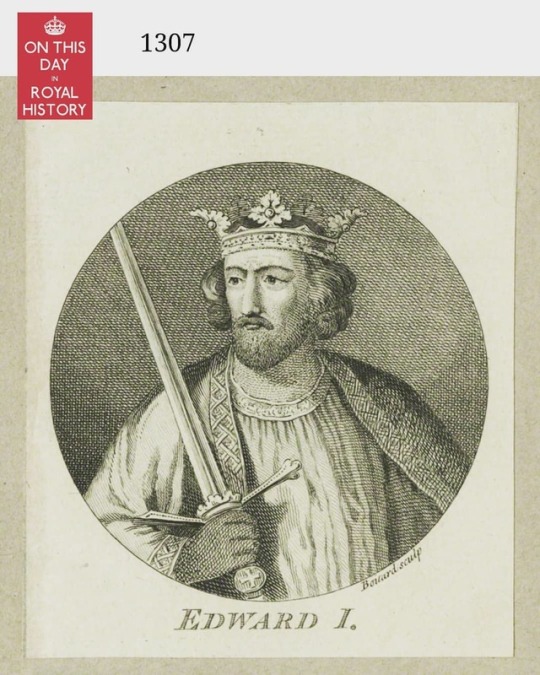
On This Day In History . 7 July 1307 . King Edward I died . 👑 Edward I (born.17 June 1239) also known as Edward Longshanks & the Hammer of the Scots, was King of England from 1272 to 1307. . . ◾ In February 1307, On his way to fight the Scots, the 68 year old king developed dysentery, & his condition deteriorated. On 6 July he encamped at Burgh by Sands, just south of the Scottish border. When his servants came the next morning to lift him up so that he could eat, he died in their arms. . ◾ The new king, Edward II, remained in the north until August, but then abandoned the campaign & headed south. He was crowned king on 25 February 1308. . ▪ Edward I's body was brought south, laying in state at Waltham Abbey, before being buried in Westminster Abbey on 27 October. There are few records of the funeral, which cost £473. . ▪ Edward's tomb was an unusually plain sarcophagus of Purbeck marble, without the customary royal effigy, possibly the result of the shortage of royal funds after the King's death. The sarcophagus may normally have been covered over with rich cloth, & originally might have been surrounded by carved busts & a devotional religious image, all since lost. . ▪ The Society of Antiquaries opened the tomb in 1774, finding that the body had been well preserved over the preceding 467 years, & took the opportunity to determine the King's original height. Traces of the Latin inscription Edwardus Primus Scottorum Malleus hic est, 1308. Pactum Serva ("Here is Edward I, Hammer of the Scots, 1308. Keep the Vow"), which can still be seen painted on the side of the tomb, referring to his vow to avenge the rebellion of Robert Bruce. . ▪ This resulted in Edward being given the epithet the "Hammer of the Scots" by historians, but is not contemporary in origin, having been added by the Abbot John Feckenham in the 16th century. . . . #Onthisdayinhistory #thisdayinhistory #theyear1307 #EdwardI #KingEdwardI #EdwardIofEngland #HouseofPlantagenet #History #Plantagenets #EnglishMonarchy #Englabdtishmonarchy #d7jul #OnThisDay #historyfacts #RoyalHistory #Longshanks #KingofEngland #InstaHistory (at Burgh by Sands) https://www.instagram.com/p/BznCnuhgCVc/?igshid=a2ifiqo1dbzx
#onthisdayinhistory#thisdayinhistory#theyear1307#edwardi#kingedwardi#edwardiofengland#houseofplantagenet#history#plantagenets#englishmonarchy#englabdtishmonarchy#d7jul#onthisday#historyfacts#royalhistory#longshanks#kingofengland#instahistory
0 notes
Photo
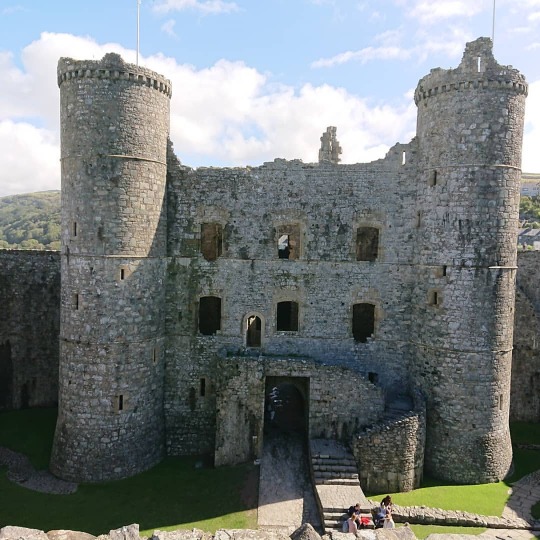
Harlech Castle
.
Harlech Castle (Welsh: Castell Harlech), located in Harlech, Gwynedd, Wales, is a medieval fortification, constructed atop a spur of rock close to the Irish Sea.
.
It was built by Edward I during his invasion of Wales between 1282 & 1289 at the relatively modest cost of £8,190.
.
The sea originally came much closer to Harlech than in modern times, & a water-gate & a long flight of steps leads down from the castle to the former shore, which allowed the castle to be resupplied by sea during sieges.
.
👑 To read more about Harlech Castle and King Edward I visit my Royal Blog, link in the bio 👑
.
.
.
#HistoricWales #Heritage #crown #britishmonarchy #RoyalHistory #HistoryFacts #British #Historic #WelshHeritage #HistoryFacts #History #castle #Castles #welshCastles #Visitwales #wales #welshCastle #Medieval #welshHistory #Harlech #Welsh #Northwales #HarlechCastle #Edwardi #KingEdwardi #longshanks #plantagenets #Plantagenet #Medieval #medievaltimes (at Harlech Castle)
https://www.instagram.com/p/B-VYacPDA8g/?igshid=m4qrgltnl1zp
#historicwales#heritage#crown#britishmonarchy#royalhistory#historyfacts#british#historic#welshheritage#history#castle#castles#welshcastles#visitwales#wales#welshcastle#medieval#welshhistory#harlech#welsh#northwales#harlechcastle#edwardi#kingedwardi#longshanks#plantagenets#plantagenet#medievaltimes
23 notes
·
View notes
Photo

Harlech Castle
.
Harlech Castle (Welsh: Castell Harlech), located in Harlech, Gwynedd, Wales, is a medieval fortification, constructed atop a spur of rock close to the Irish Sea.
.
It was built by Edward I during his invasion of Wales between 1282 & 1289 at the relatively modest cost of £8,190.
.
The sea originally came much closer to Harlech than in modern times, & a water-gate & a long flight of steps leads down from the castle to the former shore, which allowed the castle to be resupplied by sea during sieges.
.
👑 To read more about Harlech Castle and King Edward I visit my Royal Blog, link in the bio 👑
.
.
.
#HistoricWales #Heritage #crown #britishmonarchy #RoyalHistory #HistoryFacts #British #Historic #WelshHeritage #HistoryFacts #History #castle #Castles #welshCastles #Visitwales #wales #welshCastle #Medieval #welshHistory #Harlech #Welsh #Northwales #HarlechCastle #Edwardi #KingEdwardi #longshanks #plantagenets #Plantagenet #Medieval #medievaltimes (at Harlech Castle)
https://www.instagram.com/p/B-VYCOYDyjY/?igshid=9o8p2a9fty7c
#historicwales#heritage#crown#britishmonarchy#royalhistory#historyfacts#british#historic#welshheritage#history#castle#castles#welshcastles#visitwales#wales#welshcastle#medieval#welshhistory#harlech#welsh#northwales#harlechcastle#edwardi#kingedwardi#longshanks#plantagenets#plantagenet#medievaltimes
4 notes
·
View notes
Photo

On This Day In History . 16 November 1272 . Edward I accession . . ◼ On 16 November 1272, the day that his father King Henry III died, Edward was fighting in the crusades. . ◼ It was not until 24 September the following year that Edward left Acre. Arriving in Sicily, he was met with the news that his father had died. Edward was deeply saddened by this news, but rather than hurrying home at once, he made a leisurely journey northwards. This was partly due to his health being poor, but also due to a lack of urgency. . ◼ The political situation in England was stable after the mid-century upheavals, & Edward was proclaimed king at his father's death, rather than at his own coronation, as had until then been customary. . ◼ In Edward's absence, the country was governed by a royal council, led by Robert Burnell. . ◼ The new king embarked on an overland journey through Italy & France, where among other things he visited the pope in Rome & suppressed a rebellion in Gascony. Only on 2 August 1274 did he return to England, & was crowned on 19 August. . . . #OnThisDayInHistory #ThisDayInHistory #TheYear1272 #Accession #EdwardI #EdwardIofEngland #historyfacts #KingEdwardI #KingofEngland #History #HouseofPlantagenet #Plantagenet #Plantagenets #EdwardLongshanks #EnglishMonarchy #BritishMonarchy #D16Nov (at Acre, Israel) https://www.instagram.com/p/BqPL193Fya5/?utm_source=ig_tumblr_share&igshid=vpm5qosfvxws
#onthisdayinhistory#thisdayinhistory#theyear1272#accession#edwardi#edwardiofengland#historyfacts#kingedwardi#kingofengland#history#houseofplantagenet#plantagenet#plantagenets#edwardlongshanks#englishmonarchy#britishmonarchy#d16nov
0 notes